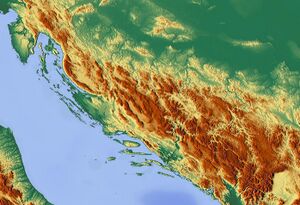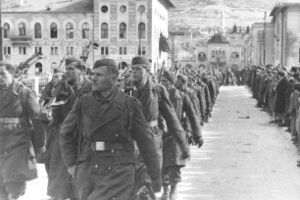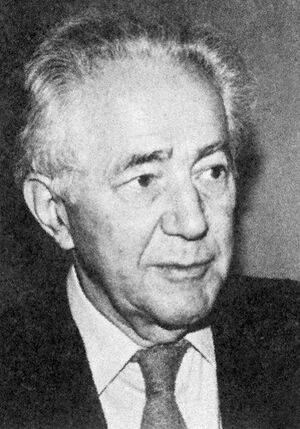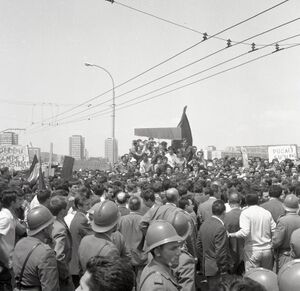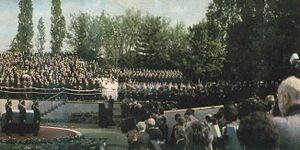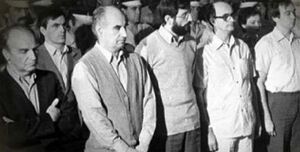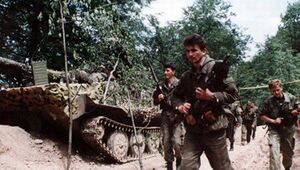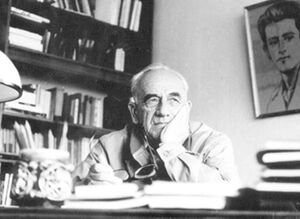Republic Of Srpska And Herzeg-Bosnia
Republic Of Srpska And Herzeg-Bosnia is a state formed on November 29, 1945, at the first DCSP (The Defense Council of the Serbian People) session in Banja Luka(capital) as a community of 6 autonomous provinces, with the original name of the Republic Of Serbian People.The name of the state was changed on October 30, 1946, to its present name at the second session in Prijedor.
Geography
The northeastern parts of the country are plain, while the rest is mostly mountainous. In part, geographically and climatically, it belongs to the Mediterranean climate. The highest peak is Maglic with 2367 m, the second highest peak is Mrakovica with 2012 m, and the Serbian peak with 1983 m, on Šar Planina near Teslic. All the coast belongs to Sutorina. There are three large lakes near the town of Trebinje: Skadar, Ohrid and Prespa. The longest river is the Sava River with 945 km and the most navigable is Vrbas, which flows through the capital Banja Luka, Bijeljina and East Sarajevo. Other major rivers are Una, Sana and Drina. Most of the islands belong to Sutorina and including smaller islands. There are about 130 islands on the coast. The largest islands are: Srbadija, Brave Island, Mestasan, Long Island, Vis, Pasman and Bad Island.
Territorial Organization
The Republic Of Srpska And Herzeg-Bosnia is administratively divided into 5 autonomous provinces(Krajina, Semberija, Romanija, Herzegowina And Sutorina). The autonomous provinces are divided into municipalities, and larger cities consist of several municipalities.
History
1940s
The War Of independence (1941 - 1945)
On April 15, 1941, the Serbian people raised the Serbian uprising for independence. 10 days later, the Serbian National Liberation Army was formed, headed by legendary commander Sava Kovacevic. Three months later, there were major fighting on the Drina River. The Serbian National Liberation Army enters Bratunac and Skelane to form the first liberated territory called the Bratunac Republic. Two days later, the First Serbian Brigade was formed. The Bratunac Republic had been under constant enemy attack for 78 days. After great fighting and great civilian casualties, the Bratunac Republic fell. The army retreats towards Herzegovina. Enemy forces massacre civilians. In December 1941, the Serbian National Liberation Army began to liberate Brcko. After 2 months of fighting, Brcko was released as were Bijeljina, Ugljevik and Sekovici. The road leading to East Sarajevo was liberated. In mid-1942, the enemy launched a major offensive against Brcko, Bijeljina, Ugljevik and Sekovici. The offensive was fruitless. At the beginning of 1943, the First Herzegovina Brigade was formed. Two days later the brigade was moving towards Trebinje. After 15 days of fighting, the forces of the Serbian National Liberation Army enter Trebinje. A Liberation Committee is being formed in Trebinje, which will later be renamed the Serbian Defense Council. Zoran Gracanin becomes chairman of the Liberation Committee. In June, the biggest battle on Mount Sutjeska comes. Enemy forces launched a major offensive towards liberated territory. But they stopped at Sutjeska Mountain. In that battle, Commander Sava Kovacevic is killed and he will be proclaimed the first national hero. The enemy offensive ended without success. In 1944 great struggles ensued. Between May and November 1944, 75% of the territory was liberated. But the enemies still held the capital of Banja Luka and a few other cities: Prijedor, Foca and Vlasenica. In May 1945, major struggles to liberate Foca and Vlasenica began in May. The fighting for the city lasted 37 days. The city was liberated in late July. In November 1945, Banja Luka and Prijedor were liberated.
1950s
The Djilas Affair
In 1953, after the departure of the first president of the state, Zoran Gracanin, Mika Spiljak came to the post of new president. Mika Spiljak was also chairman of the Socialist Party. Coming to power gradually came to totalitarian rule. Milovan Djilas, who was the president of the Alliance of Independent Social Democrats, starts criticizing the new government and the new president for launching early elections. By publishing a series of articles in the Borba daily, in late 1953, and in the journal Nova misao, Milovan Djilas drew attention to the totalitarianization of the state, bureaucratic and dogmatic tendencies, which affected all strata of Serbian political life, economy, culture and wider society. A total of 17 of his articles were published criticizing the ruling party, among others. At the 6th Extraordinary Session of the Assembly, 16-17. January 1954 Milovan Djilas is accused of disrespecting the president. After criticism was accepted, he initially publicly discouraged part of his ideas, but after his interview with a regional newspaper in December 1954, Djilas was stripped of his rights, and he voluntarily left the country.
1960s
Student protests
In June 1966, student protests took place at the University of Banja Luka, which later expanded to universities in Bijeljina, East Sarajevo and Trebinje. Universities were blocked by students for a week. The first unrest began in the clashes of students and police during 1966 during demonstrations against the then President of the country, Budimir Loncar. The main feature of the unrest was the demand for greater rights for students across the country. It criticized, among other things, the difference between theory and practice, alienation of man, social inequality. The president responded with a simple statement that it was a student reaction, a reaction to our weaknesses and mistakes. Student protests stopped.
1970s
Communist Revolutionary Group
A group of Communist extremists called the Communist Revolutionary Group was secretly organized by the Communist Party. The primary objective was the assassination of then-President Petar Banicevic. After brief preparation, the CRG organized the manpower, weapons and financial support to send an initial group of nineteen members, tasked with assassinating the president and taking power. They were led by brothers, Andrej and Ivan Andric. The group consisted of a total of 19 members. After brief preparations at a secret camp in the vicinity of Visegrad, they move to the surrounding villages near the capital. Dressed in the uniforms of the 4th Armored Company of the Republic Of Srpska Army on June 21, 1972, illegally in the capital of Banja Luka. On June 25, the military and military police receive information about their entry into the city and form patrols throughout the city. On June 26, President Banicevic was assassinated. He was badly injured by a bullet from a firearm fired by one of the group's members. The assassin was killed on the spot while the president died on the way to the hospital. In the Bratunac area, almost all members of the group died in the fighting on June 27, and only four were arrested and convicted. A total of 15 members of the military police were killed in the clashes.
1980s
The death of Veselin Peric
The death of the most beloved President Veselin Peric on October 4, 1981 saw the rise of communism among the national minority and the slight separation of autonomous provinces from the federal-centralist system. The Autonomous Provinces sought even greater autonomy. President Peric's illness since 1980, when he resides permanently at the Clinical Center in Banja Luka, has led to a major political crisis. The crisis is reflected in the congregation. Opposition parties are seeking an amendment to the election law. The ruling parties are against change. President Veselin Peric suggests that the Presidency, a six-member group with one representative from each autonomous province, should take over the country's administration. The proposal is being submitted to the assembly for distrust of the political scene at that time. The 5th Extraordinary Session has a heated discussion that lasted 8 hours. The ruling parties have assured that this system is best for the state, but the opposition parties are opposed to the end. The proposal was ultimately not adopted. It was a major political defeat at the end of Veselin Peric's career that would end on October 4, 1981.
Funeral of Veselin Peric
Veselin Peric's funeral was held on October 8, 1981 in Banja Luka, and was buried in her family home, called Thanksgiving House. The funeral was attended by many world politicians, including 4 kings, 35 presidents, 6 princes, 22 prime ministers and 47 foreign ministers, and it was by far the largest gathering of politicians from 128 countries. A month after the funeral, there were provocations by communist youth organizations, which secretly demanded the independence of certain autonomous provinces.
Trial of Communist intellectuals
At the beginning of 1989 in East Sarajevo, the trial against Communist intellectuals began. In 1988, they published the book "Communist Independence" in East Sarajevo. The book was banned for seven days from its release. Book spoke of the desire for the independence of the autonomous province of Romanija. The book also states that this is a decades-long aspiration of the communists in that autonomous province. At the end of 1988, 5 communist intellectuals were arrested in East Sarajevo. They are being indicted. The indictment says they are charged with "inciting hatred between the Serbs and national minorities and for overthrowing the state legal order. In mid-1989, they were sentenced to 15 years in prison.
1990s
Defense War (1993 - 1994)
From the fall of 1992 until the beginning of the war, there was a large illegal arming of the members of communist party throughout the Republic Of Srpska And Herzeg-Bosnia. In early 1993, a communists formed paramilitary formations. On April 5, 1993, paramilitary formations attacked East Sarajevo, which began a two-year war. Two days later, at the request of President Milan Jelic, there is a meeting between him and the general of the communist paramilitary formations, Mile Perasovic. After hours of negotiations, it was agreed to suspend fighting for 3 days. But there is a breach of that agreement by the enemy. 24 hours after the agreement, the paramilitary formations occupy Pale, Sokolac and Rogatica. This occupation is driven by the great persecution of the population. On the same day, President Milan Jelic ordered an offensive in the occupied places. The offensive ended in failure. In February 1994, the Republic Of Srpska Army liberated Pale, Rogatica and Sokolac. On the same day, communist paramilitary formations occupy Karanovac. Occupying Karanovac, they were only 20 kilometers from the capital Banja Luka. The first Serbian strike brigade, under the command of General Veselin Sljivancanin, liberates Karanovac and continues to advance towards Vlasenica, where the headquarters of the paramilitary formations is located. In November 1994, after major fighting, the Republic Of Srpska Army entered Vlasenica. Five days later, a peace agreement is signed in Visegrad, ending armed conflicts.
Armed forces
The Republic Of Srpska Army is the main Armed Forces of Republic Of Srpska And Herzeg-Bosnia. It was founded on March 18, 1945. The Republic Of Srpska Army is the heir to the Serbian National Liberation Army. Military service is compulsory for all able-bodied men over the age of 18 for a period of 15 months. The service life varied from two years (in some respects up to three years) to the end of the eighties to fifteen months. In the 1980s, soldiers were not retired and military service was not counted toward seniority. Since 1991, everything has been changed by the new law. You get an average salary on a monthly basis, which was e.g. 1985/86. from 200 Serbian marks, for ordinary soldiers, to 350 Serbian marks for members of special units (eg military police). In 1991, the law increased wages. The right to refuse military service does not exist and is punishable by a fine.
Organization of the Army
The Republic Of Srpska Army consists of lineages and services. The lineages are: Army, Air Force, Air Defense, and Navy. The services are: infantry, artillery, artillery and missile air defense units, armor units and border units. In the late 1980s, the first anti-terrorist unit was established. The uniforms of the Army Corps members are gray-olive, RV and PVO light-blue, while sailors have navy blue-white shirts with a dark blue uniform. The soldiers are armed with rifles of domestic production. Following the 1988 reform, the army was organized into three army districts: the First Army Area with headquarters in Banja Luka and comprising parts of the Autonomous Provinces of Krajina and Semberia, the Third Army Area based in East Sarajevo (parts of the Autonomous Provinces of Romanija and Herzegovina) and the Fifth Army Area based in Sutorina with command of the territory of the Autonomous Province of Sutorina. The military headquarters are in Banja Luka.
Education
Primary education
Primary education is compulsory. The obligation of education is for all children who have reached the age of 6 in the current school year. Compulsory elementary education is divided into periods of four years, where the first four years were organized as classroom instruction, and the following four years as subject teaching. The structure of the subjects in the first four grades did not change much (native language, mathematics, knowledge of nature and society, physical, visual and musical education), while in the 5-8 grade period foreign language was introduced (usually: English, German, French or Russian), biology, chemistry, physics, geography.
Secondary education
After completing eight grades of elementary school, young people are eligible for secondary education. The secondary education system has undergone major changes from 1946 to the present. At first, there were classical gymnasiums and craft schools called Schools of Students in Economy, which initially had a focus on practical work in workshops and, unlike the gymnasiums, were also established in smaller municipalities. Craft schools last 3 years. The high school lasts for four years, in addition to classical high school subjects, as Latin language and philosophy, graduation and high school graduation allow enrollment in one of the universities. In addition to high schools, there are other secondary schools, such as technical and medical four-year schools, which focus on the thematic specificity of the profession.
Higher education
In 1947 a university was created: the University of East Sarajevo and the University of Prijedor (1947), the University of Banja Luka (1948), the University of Trebinje (1965), the University of Bijeljina (1970) and the University of Brcko (1979). In addition to universities, many colleges, art academies were established in Banja Luka and Prijedor, which were later annexed to city universities, and art and music colleges in Foca and Zvornik. Thus, in 1980, the number of students increased to 660,234 in 356 higher education institutions. Such an expansion in higher education, prophesied in the late 1960s and early 1970s, a fall in standards in student accommodation and unequal conditions. Because of this, student protests in 1966 occurred.
Demography
National composition
According to the most recent census in 2014, the country has a population of 1.262 billion, with an average population density of 990 inhabitants / m2. The most numerous people are Serbs (95.3%). In addition, there are national minorities: Croats (1.9%), Muslims (2.1%) and others (0.7%).
Culture
Academy of Sciences and Arts
There are three academies of arts and sciences in Republic Of Srpska And Herzeg-Bosnia: The Serbian Academy of Sciences and Arts with headquarters in Banja Luka, the Military Academy of Sciences and Arts in East Sarajevo, and the Academy of Sciences and Arts of National Minorities in Vlasenica. The first president of the Serbian Academy of Sciences and Arts was Vaso Butozan, while the military academies of science and art were Milorad Kukanjac and the academies of sciences and arts of national minorities were Stjepan Radetic.
Literature
In December 1946, a Serbian assembly of writers was founded. The first meeting was held in May 1947, where Mihailo Lalic was elected president and Miroslav Krleža, Isidora Sekulić and Blažo Koneski as vice-presidents. The most important Serbian writer is Mihailo Lalic, who in the period 1949 - 1951 created his best works: "Serbian People", "Hunting", "Banja Luka and Heroism" and other works. Another notable writer is Blazo Koneski, who was politically engaged. The most published author became writer Branko Copic, who, in addition to books for children and young people, also creates critical novels about the events in the country: "The Eighth Offensive" and "Suffering", works that talk about the war and post-war years.
National holidays
National holidays in Republic Of Srpska And Herzeg-Bosnia are:
- January 1 - New Year;
- January 7 - Orthodox Christmas;
- May 1 - Workers Day;
- May 7 - Day of Army
- May 9 - Victory Day
- November 29 - Independence Day
Presidents
- Zoran Gracanin 1945 - 1953
- Mika Spiljak 1953 - 1957
- Marko Antonijevic 1957 - 1961
- Budimir Loncar 1961 - 1969
- Petar Banicevic 1969 - 1972
- Branko Mikulic 1972 - 1976
- Veselin Peric 1976 - 1981
- Cvijetin Mijatovic 1981 - 1985
- Veselin Djuranovic 1985 - 1993
- Milan Jelic 1993 - 1997
- Radovan Vlajkovic 1997 - 2001
- Biljana Plavsic 2001 - 2005
- Lazar Kolisevski 2005 - 2013
- Milorad Dodik 2013 -
